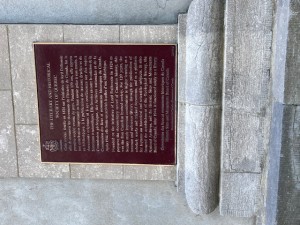
When I went to Toronto many years ago to visit my son who had moved there, he took me on a tour of the city to show me the places in Michael Ondaatje’s masterful novel In the Skin of a Lion. I had loved the novel, along with the other Can Lit books my son had recommended (Timothy Findley, Alistair MacLeod, Jane Urquhart, David Adams Richards, Margaret Laurence, etc.) at that time not available in the U.S. Somehow, seeing the actual places mentioned in Ondaatje’s book made it come alive for me in a different way.
Perhaps you have had this experience. If you read a book set in a place you know well, you have a different relationship with the story. When I read an Anne Tyler book or one by Laura Lippman, I recognise the places in and near Baltimore that they mention, and the story becomes that much more real.
A few years ago when I was in Edinburgh, I went on an Ian Rankin tour. His books are true works of literary art, and I highly recommend them. I first found one in a Toronto bookstore; they weren’t available in the U.S. and the online bookstore thing hadn’t taken hold yet. He immediately became one of my favorite authors, and I’ve enjoyed watching his immense talent increase with every book, especially those featuring detective John Rebus.
The tour was fun, taking us to places that cropped up in his books as well as to buildings where he and fellow Edinburgh authors lived. I also made an effort to look on my own for things referenced in his books, such as the miniature coffins found on Arthur’s seat and Rebus’s favorite bar.
Recently I enjoyed a tour in Quebec City that took us to places mentioned in Louise Penny’s Bury the Dead. Seeing where the incidents in the story took place, following Inspector Gamache’s footsteps, enjoying the restaurants and bistros mentioned made the story real in an entirely different way. If nothing else, I saw how short a distance it was in some cases from one place to another, making it easier to understand how Gamache could move so quickly between them.
Our tour guide Marie had some inside information: Penny herself had stayed in the house where Gamache stayed with his friend Emil in the story. Marie had seen inside and verified that it matched the description, just as we could verify the descriptions of other, more public places mentioned.
Marie speculated that Penny had eaten in these restaurants, ridden the funicular, visited the Cathedral-Basilica of Notre-Dame de Quebec. I thought: Of course she did! That’s how you research a book. All good writers do that.
When you travel, I encourage you to read novels set there and, if possible, take a tour of the places mentioned. Let me know how that changes your perception of the book.
Have you ever taken a tour of places mentioned in an author’s book? If you read a book set in a place you know well, how is the experience different?
